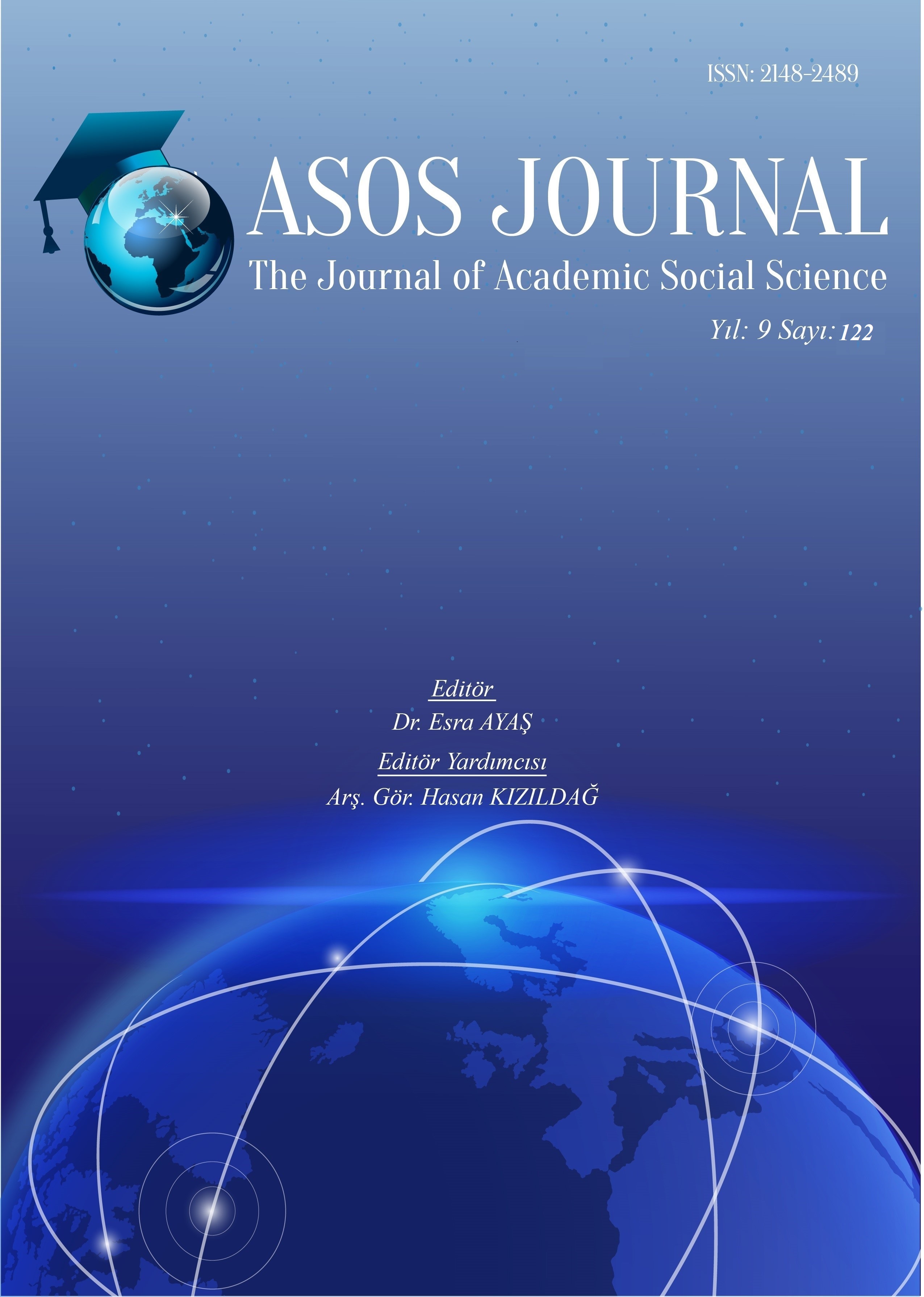Author :
Abstract
Elif Şafak’ın kurgusal yazın dünyasında ruhânî varlıkların belli bir yeri olduğu görülmektedir. Onun eserler tayfını şöyle bir gözden geçirme durumunda okur, bâriz şekilde böyle bir intiba edinir. İlk bakışta sanki bir çelmece (paradoks) gibi gelse de; anılan varlıkların romanlara katkısı, bilâkis bir realizm anlayışı istikametinde alınmalıdır; zira gerçek dünyada insanların belki de çoğunun bu gibi varlıklara inandıkları hakikati, inkâr edilemez. Ne de olsa; bir matbu yapıtta yer alan oluşumlar, gerçek yaşamda ne kadar karşılık buluyorsa; o yapıt o denli gerçeğe yakın demektir. Şafak’ın romanlarında gerçeküstücülük; eserin dokusuna ancak bir çeşni derecesinde serpilmişlerdir. Bir anonim masal veya fantastik edebiyatta görülen koyulukta veya keskinlikte değillerdir. O varlıkların bütüne getirisi, söz gelimi bir Stephen King’in yaptığı gibi, ilgili romana bir dehşet edebiyatı özelliğini asla kazandırmazlar. Katkı tam kararındadır; sırf gerektiği kadardır. Bu katkı, merak unsurunu biraz daha gübreleyip; okura fazladan bir haz ve güdü sağlar. Bütünlük içerisine parlak bir renk, bir başka canlılık ilâvesine yarar. Yazarın çalışılan altı eserinin kimisinde ruhânî temler biraz daha belirgin olsalar da hiç birinde onların tümden noksanlığı söz konusu değildir.
Keywords
Abstract
One can see that spiritual beings do occupy a certain place in the fictive literary world of Elif Şafak. Having skimmed her spectrum of works, the reader gains an apparent impression in this line of thought. Even though at first sight it looks as if it were a paradox; just on the contrary; the existence of such beings should be taken as a contribution in the sense of furthering realism; because it cannot be denied that in the real world; perhaps most of the people do believe in such beings. After all; the more the processed formations in a printed work correspond to real life; the more realistic is to be considered the related book. The quality of surrealism spreads throughout the work merely to the extent of a kind of taste-seasoning or flavor. It is by no means at the concentration or accuracy in an anonymous fairy-tale or in a piece of fantastic literature. The plus values involved never impart the trait of horror onto the written novel, unlike the case of Stephen King, for instance. The contribution is exactly at the optimum level, is just at the required amount. It sort of fertilizes the element of curiosity, bringing in extra enjoyment and motivation for the reader. It serves to add a bright color and a different vivaciousness into the book’s entirety. Within some of the studied six works, the spiritual themes are a bit more conspicuous; nevertheless, the complete lack of such themes in any one work is unthinkable.
Keywords
- Adasal, Rasim (1977). Normal ve Anormal Yönleriyle Yeni Medikal Psikoloji, 3. baskı, Minnetoğlu Yayınları, Cağaloğlu, İstanbul.
- Barber, Paul (1988). Vampires, Burial & Death: Folklore & Reality, New Haven-Connecticut & London.
- Cannon, Walter B. (1957).” « ‘Voodoo’ Death», Psychosomatic Medicine, Vol. XIX, No. 3, pp. 182-190.
- Coşkun İsmail & Erkilet Alev (2010). “Kapıya Geleni Geri Çevirmemek: İstanbul Esnafının Dilencilik Olgusuna Bakış Açısı”, Sosyoloji Dergisi, 3. Dizi, 20. Sayı, 2010/1, ss. 1-21.
- Çaya, Sinan & Özarboy, Ali (Eylül 2015). “Amatör Sporların Sosyo-Kültürel ve İktisadî Boyutu”, Sosyal Bilimler Dergisi / The Journal of Social Science (SOBİDER), yıl:2, sayı:4, ss. 247-257.
- Çaya, Sinan (2021a). “Contemporary Social Theories” lisans dersi yansıları, İstinye Üniversitesi-İnsan ve Toplum Bilimleri Fakültesi, Sosyoloji Bölümü, Topkapı (Cevizlibağ) Kampüsü, İstanbul.
- __________ (2021b). “Behavioral Sciences for Engineers” lisans dersi yansıları, Marmara Üniversitesi-Mühendislik Fakültesi (Yeni Yerleşkesi), Küçükyalı, İstanbul.
- Erdem, Sargon (1992). “Buhur”, Türkiye Diyanet Vakfı İslâm Ansiklopedisi, cilt VI, Kocatepe, Ankara.
- Gordon, Noah (1986). The Physician, Simon & Schuster Publishing, New York.
- Kücheman, Fridtjof (10. 10. 2016). “Das letzte Abendmahl des Türkischen Großbürgertums”, Frankfurter Allgemeine Zeitung.
- Mağden, Perihan (1991). Haberci Çocuk Cinayetleri, İletişim Yayınları, İstanbul.
- Makal, Mahmut (1961). Bizim Köy, Varlık Yayınları, Cağaloğlu-İstanbul.
- Müslümoğlu, Mustafa (04 Ekim 2019). “Kur’an-ı Kerim’e göre Dünyada Yaşayan Ruhânî Varlıklar”, Gazete Yenigün.
- Nicolas, Michèle (1972). Croyances et pratiques populaires Turques concernant les naissances (région de Bergama), imprimerie A. Bontemps, Limoges (France).
- Ran, Nâzım Hikmet (1966, 1987). Memleketimden İnsan Manzaraları: Şiirler 5, Yedinci Basım, Adam Yayıncılık, İstanbul.
- Sardarinia, Elnaz (2016). Doğu Azerbaycan Halk Kültüründe Geçiş Dönemleri, basılmamış yüksek lisans tezi, Hacettepe Üniversitesi Sosyal Bilimler Enstitüsü, Ankara.
- Şafak, Elif (2007). The Bastard of İstanbul, Viking Press, New York.
- ———— (2009). Aşk [İngilizce başlık: The Forty Rules of Love], Doğan Kitap, İstanbul.
- ———— (2011). Ehre [Türkçe başlık: İskender; İngilizce başlık: Honor], İngilizce’den Almanca’ya tercümesi: Michaela Grabinger, Kein & Aber e-Book.
- ———— (2002, 2014). Bit Palas [İngilizce başlık: The Flea Palace], Doğan Kitap, İstanbul.
- ———— (2016). Black Milk: On Writing, Motherhood and the Harem within [Siyah Süt], trans. by Hande Zapsu, Viking Press, New York.
- ———— (Oktober-2016). Der Geruch des Paradieses [Türkçe başlık: Havva’nın Üç Kızı; İngilizce başlık: Three Daughters of Eve], İngilizce’den Almanca’ya tercümesi: Michaela Grabinger, Kein & Aber e-Book.
- Tekin, Lâtife (2013). Sevgili Arsız Ölüm, İletişim Yayınları, Cağaloğlu-İstanbul.





